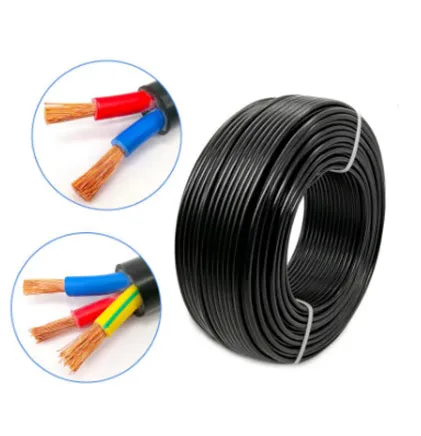
Cable Conductor Material Analysis: Copper Cables vs. Aluminum Cables, Costs, and Performance

Hey there! If you've ever wondered why some cables work differently than others, or why electricians might recommend one type over another, you're in the right place. Today we're diving deep into the world of cable conductors—specifically copper vs. aluminum. Whether you're wiring a new home, upgrading your office network, or just curious about how electricity travels, this guide breaks down everything in plain English. No engineering degree required, promise!
Bottom line up front : Copper generally performs better but costs more; aluminum is budget-friendly but has technical trade-offs. Your specific needs—budget, installation environment, and performance requirements—will determine the winner for your situation.
The Basics: What Makes Conductors Tick
Conductivity 101
Conductivity determines how efficiently electricity flows through a material. Think of it like water flowing through pipes—copper pipes allow water to flow more freely than aluminum ones. Copper has about 61% higher conductivity than aluminum. That means for the same electrical load, aluminum cables need to be about 56% larger in cross-section to match copper's performance. This isn't just a minor difference; it significantly impacts both installation flexibility and long-term efficiency.
Temperature also plays a big role. Aluminum's conductivity drops faster than copper's as things heat up. If your cables are running through a hot attic or industrial setting, this becomes crucial to avoid energy waste or safety risks.
Copper Cables: The Premium Choice
Why Copper Reigns Supreme
Copper has been the go-to conductor for over a century. Here's what makes it special:
- Superior Conductivity : Moves electricity more efficiently with less energy loss.
- Durability : Resists corrosion and maintains integrity for decades.
- Flexibility : Easier to bend and install in tight spaces.
- Reliability : Minimal expansion/contraction with temperature changes.
These advantages make copper ideal for sensitive applications like audio systems, medical equipment, and high-frequency data transmission where signal integrity is non-negotiable. As a professional china cable manufacturer might tell you, premium installations almost always default to copper.
The Cost Reality
Here's the catch: Copper currently costs about $8,500 per metric ton versus aluminum's $2,300. For a typical home wiring project, copper can be 2-3 times more expensive upfront. But before you balk at the price, consider longevity—copper systems often last 40+ years with near-zero maintenance, while aluminum might require re-terminations every 10-15 years.
Aluminum Cables: The Budget Alternative
Where Aluminum Shines
Aluminum makes sense in several scenarios:
- Large-Scale Projects : Power grids and transmission lines where weight savings matter.
- Non-Critical Circuits : General household wiring in dry, temperature-stable areas.
- Short Runs : Where voltage drop is negligible.
Modern aluminum alloys (like AA-8000 series) perform much better than older versions, reducing fire risks. However, they still require antioxidant pastes at connection points and specialized connectors to prevent loosening over time.
Hidden Costs & Safety
Aluminum's lower cost comes with caveats:
- Thicker cables need larger conduits and supports
- More complex termination process
- Higher energy losses (3-5% more than copper)
- Higher insurance premiums in some regions
Safety tip: Aluminum expands 30% more than copper when heated. In improperly installed systems, this can lead to loose connections—a leading cause of electrical fires.
Head-to-Head Comparison
| Feature | Copper | Aluminum |
|---|---|---|
| Conductivity | 100% IACS | 61% IACS |
| Typical Lifespan | 40-100 years | 20-40 years |
| Material Cost (per lb) | $3.85 | $1.04 |
| Weight Comparison | Heavier (8.96 g/cm³) | Lighter (2.7 g/cm³) |
| Corrosion Resistance | Excellent | Good (with treatments) |
| Flexibility | High | Moderate |
Real-World Applications
Residential Wiring
Copper dominates branch circuits (outlets, lights) due to safety and reliability. Aluminum sometimes appears in service entrance cables where cost savings outweigh drawbacks. Fun fact: Many modern smart homes use copper for its superior data transmission capabilities.
Industrial & Commercial
Factories love aluminum for main feeders where distances are long and costs add up. Data centers? Nearly 100% copper—those server farms can't afford millisecond delays or heat buildup.
Future Trends: What's Changing?
Copper-Clad Aluminum (CCA)
The hybrid solution: aluminum core with copper coating. Offers 70% of copper's performance at 50% cost. Currently popular in budget network cables, but controversial for power applications due to potential de-lamination issues.
Sustainability Matters
Aluminum scores big on recyclability—it takes 95% less energy to recycle than to produce new. Copper is infinitely recyclable too, but mining impacts are greater. Expect eco-regulations to increasingly influence material choices.
Final Decision Framework : Choose copper when safety, longevity, or performance are priorities. Opt for aluminum when budget dominates, distances are long, or weight is critical. Hybrid solutions like CCA offer middle ground but vet suppliers carefully.
Conclusion: Matching Material to Mission
At the end of the day, there's no universal "best" conductor—only what's best for your specific situation. Copper delivers uncompromising performance and safety where it matters most. Aluminum offers practical savings in large-scale or non-critical applications. As technologies evolve and material science advances, we might see this equation shift. But for now, understanding these fundamental differences empowers you to make informed, cost-effective, and safe decisions—whether you're wiring a garden shed or specifying systems for a skyscraper.
Whatever you choose, remember: quality installation matters more than material alone. A poorly terminated copper cable can fail faster than a well-installed aluminum one. When in doubt, consult a professional electrician who understands your local conditions and requirements.
Tags:
Recommend Products











